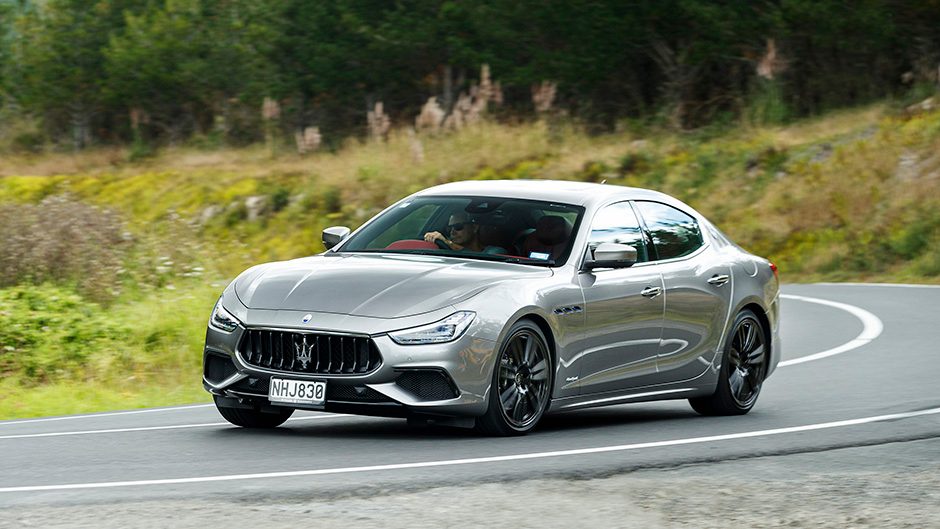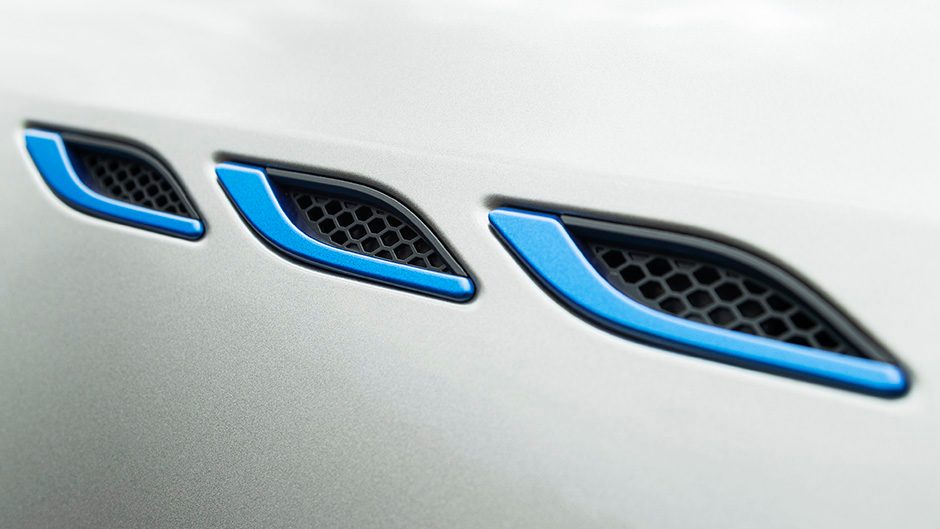2021 Maserati Ghibli GranSport hybrid review
Words Kyle Cassidy | Photos Tom Gasnier
The famous trident brand takes its first electrified steps with the Ghibli hybrid. Is it the Maserati for you?
A hybrid can be many things. There are those that can hum along on electricity alone, like plug-ins, and others use an electric motor to aid the engine. Also in the mix are mild hybrids. These tend to use lower voltage electrical gizmos to improve emissions or boost the performance of the combustion engine without the costly need of an actual electric motor. And the latter is what Maserati has done with its first electrified car, the Ghibli Hybrid.
The Hybrid is said to allow it to ‘enter the world of electrification without altering the brand’s core philosophy and values’. Except the Ghibli Hybrid is a four cylinder, the brand’s first road car with a pot count fewer than six. So it’s a gentle introduction to volts for the trident brand, but things are set to amp up quickly. Maserati reckons it will have an EV version of all of its models by 2024. That’s just three years away. The first will be the new GranTurismo and GranCabrio models which are due later this year, complete with a triple motor layout (one up the front and two on the rear). Its MC 20 super sports car will also offer a battery powered version and a new, smaller-than-a-Levante SUV, dubbed Grecale, will have both conventional ICE and EV powertrains. So after a few years of sluggish sales and product inaction, it seems the stove is back on at Maserati and they are cooking again.

As with any hybrid, the aim of the Ghibli version is to cut emissions, the four cylinder better than the V6 models on gas use and CO2 output, while emissions in terms of NOX and other nasties are improved over the old diesels which are no longer available. It’s also quicker than the former oilers too.
The hybrid tech here amounts to a 48v system powering an e-booster, or an electric supercharger device that bulks up the low-end torque delivery of the 2.0-litre engine before the regular turbocharger comes online. There’s a small 48v battery under the boot floor in the spare wheel well, and it is charged by a 48v alternator set-up when decelerating.
Maserati says the Hybrid is 80kg lighter than the diesel it effectively replaces and, with a lighter engine up front along with a battery in the boot, the weight split is improved. We measured it at 50.6/49.4 front to rear. The net result is a 2.0-litre turbo with 246kW and 450Nm at 1500rpm. For reference the old 3.0-litre diesel made 202kW and 600Nm.

It’s not what you’d call a hypermiler hybrid however. The consumption figures are quoted at between 8.5-9.6L/100km,depending on options as per WLTP variations. If you buy the Ghibli, its 3.0-litre twin-turbo V6 petrol makes 257kW and 500Nm at 1750rpm and is rated at 11.1L/100km. Pricing sees the Hybrid start at $140,000, making it the cheapest Ghibli, while this Gran Sport version is $160,000. The comparable V6-powered Ghiblis are $4500 more expensive, so there’s a handy saving by going hybrid.
And it’s worth a drive for those shopping at the entry level of Ghibli ownership. The torque delivery is quite something for an engine displacing just two litres. Thank the supercharger for plumping the torque curve right up. As such, this 1990kg sports sedan moves off rather effortlessly. They say it’ll hit 100km/h in 5.7 seconds, though we couldn’t get it lower than 6.0sec. It’s not bad though, and neither is the overtake of 3.7seconds. But it’s more the in-gear pull from down low that is so impressive. It lugs up hills in diesel-like fashion, without the need to chop multiple gears, and ‘rolls on’ rather easily too. Round town, there’s minimal turbo lag, as expected, and little need to constantly massage the gas pedal as engine speeds below 2500rpm suffice for everyday running. Still, this Ghibli is almost two tonnes, and so fuel use was up around the 10.5L/100km bracket for urban running. The Merc E 200 we had last month returned better figures, though this is packing more firepower.
And what about the Hybrid’s soundtrack? Start any car with the Trident badge and it awakens with a roar, the exhaust pipes sounding off, but not this one. It sounds like any other four cylinder when you prod the go button. But it does have an interesting note when you’re standing alongside. It’s hard to describe; it doesn’t sound like a four cylinder, it’s something a bit different, thanks to the ‘optimised exhaust with specially designed resonators’. It has a more pronounced note under the pump than your usual two litre, but it’ll never be mistaken for anything exotic.

The Hybrid uses the same ZF-sourced eight-speed auto as the rest of the range, and it gets the same ‘Skyhook’ adaptive suspension and LSD. Being an Italian sports sedan, the ride is, er, sporty (and the turning circle larger than desirable). So don’t be expecting a plush limo-type waft around town. And it can be an expert at detecting most edges on highways when cruising. However, your derriere does adjust and the firmish ride comes with competent damping so it settles quickly over the dips and bumps. And in typical Italian fashion, the progress gets better the more you drive it in a Maserati-like manner.
The Hybrid is quite the honey to hound down a winding road. Its mass is nicely distributed so it has a neutral feel in the bends. It points keenly, latching on to your intended line and the steering is reasonably chatty and well assisted. The damper button allows access to better roll control, with the usual trade off from the suspension stiffening.
Its hybrid powertrain delivers sufficient power too, especially when speed limits are being dialled back all over the show. This is not going to break any necks with its turn of pace, but there’s a rich midrange to keep things lively. Like most of these blown 2.0-litres (this one derived from Alfa Romeo), it’s done by 6000rpm, so the middling revs are the ones you use most. And the gearbox, even in Sport mode, isn’t too keen to rev it hard anyway. While it might be labelled a hybrid, it does start drinking in true turbo fashion when lashed, the fuel read-out nudging up into the mid-teens rather quickly. While the brakes do a decent job of hauling you up, the pedal feel is a mite mushy, making the stopping action harder to modulate.

The Hybrid gains itself a new front grille and the rear light clusters have been restyled in a boomerang form, reminiscent of the old 3200 GT. There is a subtle blue hue to the side air ducts, brake calipers and badging to mark it out as the Hybrid.
Cabin ambience has improved since we last sat in a Ghibli, helped by a new infotainment screen. The bigger, brighter 10-inch unit integrates more seamlessly into the facia, appearing more modern. The graphics, operating system and user interface are all new and there are more connected features. They’ve devised a wireless charging cradle at the bottom of the centre stack too. It’s well disguised behind a folding panel, and while it’s a little fiddly in operation, it does hold your device secure in place when driving. This is a $512 option however.
There are still some plastics and buttons borrowed from the FCA parts bin that undermine the luxury aim and price tag of the Ghibli but there are also plenty of nice touches, like the exquisite shift paddles. Spending a few more dollars on options like the full premium leather package ($4832) is a must.

As to practicality, the Ghibli is a 4+1, the rear seat space adequate but the entry is tight, and so too the headroom if you’re bigger than the average bear. Opening up the powered bootlid reveals a hold that initially looks a tad mean, but it’s long with 500L on offer evidently, and there is even a split folding function too.
Standard features include LED lights, sunroof, powered bootlid, surround view camera, smart key and the usual active driver aids. Most of the options available concern cosmetic upgrades like the carbon fibre finish for the centre console ($2080) and Alcantara headlining ($3120).
We’re not sure whether the Hybrid will truly satisfy those who bought the diesel previously, but then all the Ghibli’s competitors have gone the same way. Diesels are done in Europe and hybrids are their replacements. Whether a four cylinder will satisfy your aspirations to own a Maserati is the question you need to ask, but we like its sweet balance and its easy torque with less gas consumed versus the V6.










